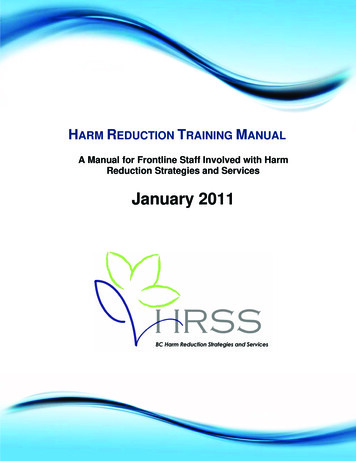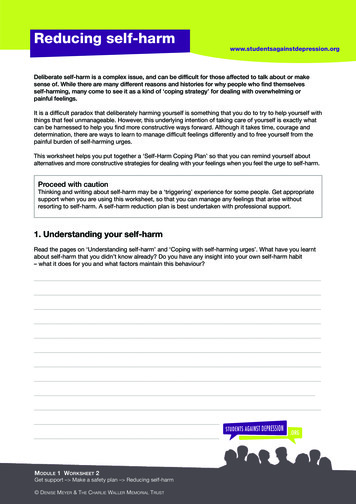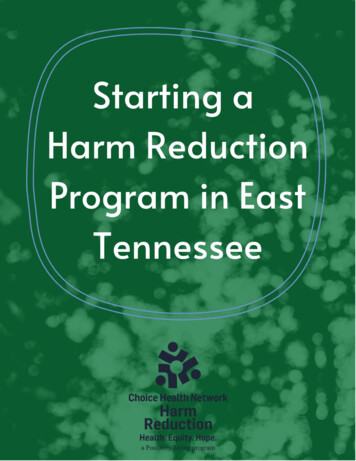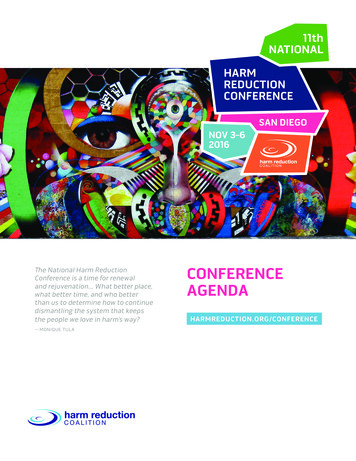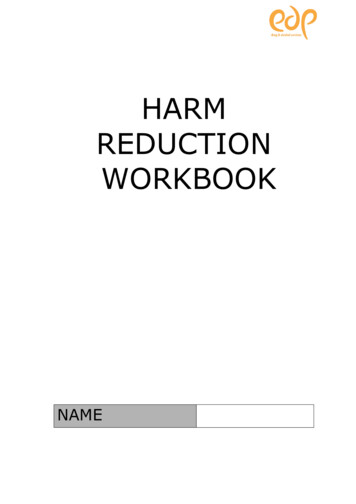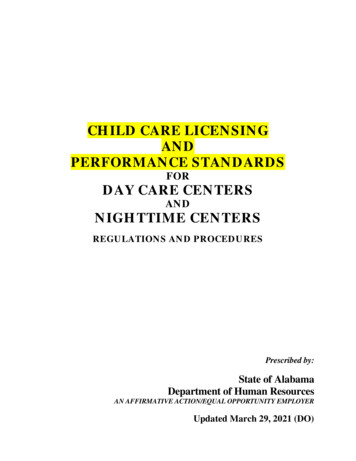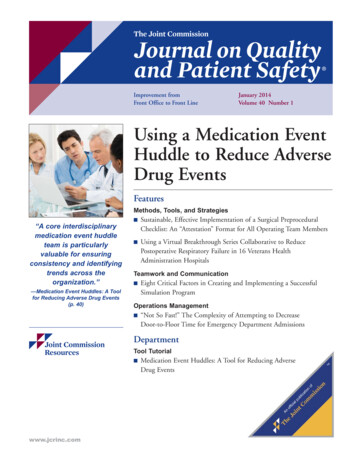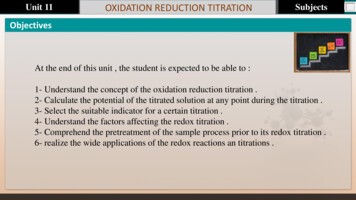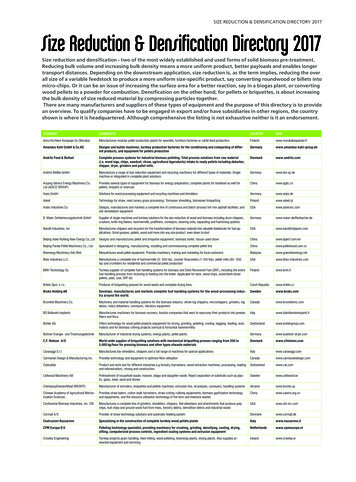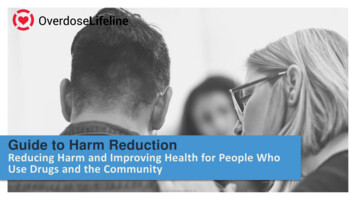
Transcription
Guide to Harm ReductionReducing Harm and Improving Health for People WhoUse Drugs and the CommunityOverdoseLifeline.orgCopyright Overdose Lifeline, Inc.
Person-first language helps to maintain anenvironment of dignity, respect and hope.Using person first language is also a more accurateway of speaking about people. Placing the personfirst and the diagnosis or behavior second helpseliminate stereotypes that can form.OverdoseLifeline.orgCopyright Overdose Lifeline, Inc.
Let’s dive deeper Established language Addiction and/or Substance use disorder (SUD) Sam is a person with addiction People with substance use disorderHarm Reduction language applied Sam is a person with problematic use or chaotic use —terminology that many who are having difficulty managingtheir drug use prefer to the term “disorder”. People who use drugsOverdoseLifeline.orgCopyright Overdose Lifeline, Inc.
It’s important to let the person you areworking with define their relationships todrugs and drug use and find terminologythat works for them.OverdoseLifeline.orgCopyright Overdose Lifeline, Inc.
Important terminologyPWUD People who use drugsPWIDPeople who inject drugsORWOutreach workerSASSyringe Access ServicesSSPSyringe Service Programs / Needle Service Programs (NSP)SCSSafe Consumption SpaceOverdoseLifeline.orgCopyright Overdose Lifeline, Inc.
What is harm?“Harm is, simply, anything that happens, no matter whatcauses it, that damages any part of you, your life, or thosearound you. Harm can be physical, emotional, social, or, somewould say, spiritual.”— Patt Denning, harm reduction psychotherapistOverdoseLifeline.orgCopyright Overdose Lifeline, Inc.
Harm Reductionists realize that abstinence is not practical foreveryone. Some people have mental health or physical healthchallenges that improve with medication and get worse withabstinence.While Harm Reductionists support abstinence as a recoverygoal, they leave goal setting to the client and support otherrecovery goals, beyond abstinence, as well.OverdoseLifeline.orgCopyright Overdose Lifeline, Inc.
Harm Reduction versus Harm EliminationIn the broad sense of the word, Harm Reduction includes everystrategy which helps to reduce harm including abstinence.The most effective strategy is to meet people where they are at andwork with individuals on goals which they choose for themselves.In the narrow sense of the word those who seek to eliminate all harmby pursuing perfect moderation or perfect abstinence may be said tobe pursuing a goal of Harm Elimination rather than Harm Reduction.Harm Elimination is not for everyone.OverdoseLifeline.orgCopyright Overdose Lifeline, Inc.Source: HAMS Harms Reduction Network
Harm Reduction Strengthen Public SafetyPrevents Disease Transmissionand injuryReducing PublicNuisanceProvides an Entry Point forPeople into ServicesDevelops MeaningfulPartnerships: Community,Public Health & Safety, andBusiness GroupsSource: Katal, Center for Health, Equity and Justice. What is Harm ReductionOverdoseLifeline.orgCopyright Overdose Lifeline, Inc.
Benefits of Harm ReductionIncrease Referrals to Support Programsand Health and Social ServicesIncrease Knowledge Around SaferSubstance UseReduce Overdose Deaths and Early DeathsReduce stigma and increase access tohealth servicesReach Vulnerable Populations andCommunitiesReduce Hepatitis C and HIVGenerates healthcare cost savings, forevery 1-2 spent in HR, 5-7 savedOverdoseLifeline.orgReduce Sharing of Substance UseEquipmentCopyright Overdose Lifeline, Inc.Source: Understanding Harm Reduction: Substance Use, Healthlink BC
Who are Harm Reductionists and What they do?OUTREACHWORKERS:Deliver MedicalSupplies toPWUDNURSES ANDDOCTORS:Concern are theHealth of PWUDEDUCATORS TOINDIVIDUALS ORCOMMUNITY:Safer Use, AboutNaloxonePOLICY MAKERS, SOME LOBBYIST:Make Sure that Drug Laws that arePassed are Ethical, Compassionateand EffectiveOverdoseLifeline.orgCopyright Overdose Lifeline, Inc.PSYCHOTHERAPIST:Provide Supportto clients whouse drugs or areAbstinentPWUD ANDCOMMUNITY:Organize to MakeSure PWUD Voicesare HeardINDIVIDUALS:Who use HR as their recovery pathwayto a better life
section 03Foundations in HarmReduction ApproachesOverdoseLifeline.orgCopyright Overdose Lifeline, Inc.
Harm reduction incorporates a spectrum of evidencebased and evidence-informed strategies from saferuse, to managed use, to abstinence to meet drugusers “where they’re at,” addressing conditions ofuse along with the use itself.OverdoseLifeline.orgCopyright Overdose Lifeline, Inc.Source: Harm Reduction Coalition
Evidence-based approachNearly 30 years of research has shown thatcomprehensive Syringe Service Programs (SSPs) are safe,effective, and cost-saving, do not increase illegal drug useor crime, and play an important role in reducing thetransmission of viral hepatitis, HIV and other infections.SSPs Increase Entry Into Substance Use Disorder Treatment:Research shows that people accessing SSPs are 5 times as likely toaccess treatment for substance use disorder and about three timesmore likely to stop using drugs than those who don’t use the programs.OverdoseLifeline.orgSource: Hagan H et al,“Reduced injection frequency and increased entry and retention in drug treatmentassociated with needle-exchange participation in Seattle drug injectors and CSC, Summary of Information onCopyright Overdose Lifeline, Inc.The Safety and Effectiveness of Syringe Services Programs (SSPs)
Evidence-based approach2005 San Francisco, CA study, injection drug usersreceived naloxone kits and CPR training 6-month follow-up (interview), no evidence of increased drug use Found decreased heroin use among participants Participants entering drug treatment increased from 35% to 60% - Eventhough the program did not promote reduction in drug use or drug treatmentIn a similar 2010 program in Los Angeles, CA 53% of program participants reported decreased drug use at 3 monthsfollow-up (interview)OverdoseLifeline.orgSources: Seal et al, Attitudes about prescribing take-home naloxone to injection drug users for the management ofheroin. Wagner et al, Evaluation of an overdose prevention and response training programme for injection drugCopyright Overdose Lifeline, Inc.users in the Skid Row area of Los Angeles
Harm Reduction ACCESSSUPPORTLINKAGESTo HarmReducingToolsBasic Healthand SocialNeedsTo ServicesHIV, HEP C,SUD, MentalHealthSource: Harm Reduction CoalitionOverdoseLifeline.orgCopyright Overdose Lifeline, Inc.
Important: Harm reduction strategies andresponses need to look different fordifferent communities.OverdoseLifeline.orgCopyright Overdose Lifeline, Inc.Source: Harm Reduction Coalition
Substance Use Management (SUM)Substance use management is a practice that does not requireabstinence but instead focuses on a range of options forimprovements while still including abstinence among the possibleself-selected outcomes.Well-managed drug use meets a person’s needs while not causingharm to others or unnecessary harm to the PWUD.The goal of SUM is Any Positive Change while addressing issuesrelated to drug use.OverdoseLifeline.orgCopyright Overdose Lifeline, Inc.Source: Bigg D. Substance use management: a harm reduction-principled approach toassisting the relief of drug-related problems
Continuum of substance useHarms can occur at any point and should be addressed, regardless of wherethe person is on the continuum.No UseChaotic / PersistentHabitual / DailyRitual BingeOverdoseLifeline.orgExperimentalor SituationalSocialRegular UseSource:Copyright Overdose Lifeline,Inc.Jeannie Little, LCSW, CGP What's Under the Harm Reduction Umbrella?, The Fix, May 2015
Continuum of substance use is not linearand may be drug specificA person can move back and for within thecontinuum, it’s not just a one-way pathPeople can be at different points for differentsubstancesTraditional notions of recovery do not always make space of this optionwhich can cause more challenges for individuals.OverdoseLifeline.orgCopyright Overdose Lifeline, Inc.
SUD Continuum of Care and Examples ofRecovery-Oriented ActivitiesPrevention Early Screening,Before Onset Collaborate withother systems (childwelfare, VA) Stigma reductionactivities Refer to interventiontreatment servicesIntervention ScreeningEarly InterventionPre-TreatmentRecovery SupportServices Outreach ServicesTreatment Menu of TreatmentServices Recovery SupportServices Alternative Servicesand Therapies Prevention andSupport for Familiesof IndividualHarm Reduction ActivitiesOverdoseLifeline.orgCopyright Overdose Lifeline, Inc.Post-Treatment Continuing Care Recovery SupportServices Check-ups Self-Monitoring
Stages of change05 Maintenance05Change has becomeintegrated with life04 ActionCommitment and Beginningto ChangeSource: Prochaska, DiClemente, & Norcross, EnhancingMotivation for Change in Substance Abuse Treatment 199201 Precontemplation0104Not thinking about change0202 ContemplationConsidering ChangeIn Harm Reduction RecoveryBEGINS HERE0303 PreparationOverdoseLifeline.orgCopyright Overdose Lifeline, Inc.Making Decisions for Change
Drug, Set, Setting — Areas forImprovementHow people’s relationship with a drug varies based on the interactionbetween three sets of factors:DRUG:the drug, how it’staken, its effectSET:SETTING:the individual user,the physical andmental statewhere and whendrug is used, stressand supportHarm Reduction looks at where improvements can be made acrossDrug, Set, and Setting.OverdoseLifeline.orgCopyright Overdose Lifeline, Inc.
Often service providers jump to the DRUG part of the model and wantto focus immediately on addressing potential harms here.Its important to assess with your participant what they want toprioritize. Maybe its their SET and other health care or mental health ortheMaybeindividualprioritizewhatfoodAllowaccess issues.its SETTING,tohavinga safe place tostay anddevelopingsupportbefore addressing their drug use.they theirwantto networksaddress.Its much easier to think about making changes in your drug use whenyou don’t feel hungry or have a tooth ache or uncontrolled diabetes or asafe place to stay.OverdoseLifeline.orgCopyright Overdose Lifeline, Inc.Source: Harm Reduction Coalition
SetSettingWhat is the drug itself andwhat it does and howpotent it isPerson’s unique personalityStress in a person’s life:social, economic,environmentalWhat is it cut withPerson’s physical andmental health, oremotional stateSupport in someone’s lifeHow is it used: smoke,snort, absorbed,swallowed, injectedPerson’s cultural identity,culture of origin, sense ofbelongingWith whom/where aperson uses. Alone or withsomeone. Injected byanother.Whether it is legal or illegalPerson’s expectation of thedrug and motivation forusing the drugSocial and cultural attitudestoward the drugDrugOverdoseLifeline.orgCopyright Overdose Lifeline, Inc.Source: Denning and Little, Practicing Harm ReductionPsychotherapy, 2012
Ideal or Successful Model for HRSTRUCTURAL SUPPORT: Legislation, Funding/Support, ReducedRegulatory Barriers, Stigma and Racism, and Resources Allocated toEvidence-based ApproachesSERVICES: Meeting needPEOPLE INVOLVED: People Who Use Drugs, Family/Friendimpacted, Providers, Local Government, Community groups/neighborsSource: Harm Reduction CoalitionOverdoseLifeline.orgCopyright Overdose Lifeline, Inc.
section 04Practicing Harm ReductionOverdoseLifeline.orgCopyright Overdose Lifeline, Inc.
What does it mean to “practice” harmreduction?Harm Reduction Principles Tools and Services Practicing Harm ReductionOverdoseLifeline.orgCopyright Overdose Lifeline, Inc.Source: Harm Reduction Coalition
Harm Reduction can be understood as a set of values or principles thatcan be applied to practices or services.Therefore, you can have services that are not rooted in a harmreduction approach (even something like syringe exchange or naloxonedistribution) and you can have services that are not what wetraditionally think of as harm reduction (like a jail-based program or anabstinence-based treatment program) and it can be rooted in harmreduction principles.— Eliza Wheeler, formerly with Harm Reduction CoalitionSource: Harm Reduction CoalitionOverdoseLifeline.orgCopyright Overdose Lifeline, Inc.
Harm Reduction PrinciplesOverdoseLifeline.orgAcknowledge RealitiesParticipant InvolvementContinuum and Perplexityof UseParticipant AutonomyHealth and DignitySociocultural FactorsParticipant CenteredServicesPragmatism and RealismCopyright Overdose Lifeline, Inc.
Stigma When we apply all these principles We challenge and address the stigma associated with this disease.With no judgement there is less stigmatization and moreopportunity, support, health and wellness.OverdoseLifeline.orgCopyright Overdose Lifeline, Inc.
EducationPeerEducation:Peers on:First Aid Trainingand NaloxoneCopyright Overdose Lifeline, Inc.RiskReductionand SaferDrug Use
Access & EngagementDrop-in CentersOverdoseLifeline.orgOutreachMobile HealthCopyright Overdose Lifeline, Inc.ConfidentialCounseling &Testing for HIV,HCV, otherBloodborneInfections
Syringe-focused ProgramsSyringe Disposal ProgramsSyringe Distribution ProgramsSafe Consumption Sites or Spaces /Safe Injection SitesOverdoseLifeline.orgCopyright Overdose Lifeline, Inc.
Linkage to Support and ServicesPrimary Carefor General /Overall Healthand WellnessOverdoseLifeline.orgHousing andHomelessnessServicesSubstance UseTreatment (incl.MAT) andMental HealthServicesCopyright Overdose Lifeline, Inc.Social, Culturaland Faithbased Support
section 05Harm Reduction MythsOverdoseLifeline.orgCopyright Overdose Lifeline, Inc.
Harm reduction encouragespeople to use substancesMYTHResearch shows that harm reduction activities do not encouragesubstance use. In fact, they can encourage people who use substancesto start treatment.OverdoseLifeline.orgCopyright Overdose Lifeline, Inc.
Abstinence-based treatment modelsare not supported in Harm ReductionMYTHAbstinence-based treatment models are supported. While harmreduction approaches often serve as a bridge to treatment or cessationof drug use, these outcomes are not preconditions or the only goals.Harm reduction neither prescribes abstinence nor uses coercive tactics toelicit it, because such tactics may inadvertently cause more harm.Harm Reduction can also address a range of issues that support the person tobe in better health and shape if and when they can decide to access treatmentwhich can optimize the chances of folks reaching their recovery goals.OverdoseLifeline.orgCopyright Overdose Lifeline, Inc.Sources: Harm Reduction Coalition
Harm reduction and lawenforcement are in conflictMYTHSuccessful Harm Reduction models find these community partners providingleadership and guidance in the development of programs that aim to reducedrug related harm to individuals and communities. Refer people to drug treatment agencies or other types of assistance Act as a useful resource for schools in drug education programs and takepart in community education about drugs and/or HIV risks Provide a supportive environment for syringe services programs by nottargeting the vicinity of these programs to arrest users Avoid arrests at the scene of a drug overdose therefore encouraging peopleto call 911 for medical help without delay or fear of prosecutionOverdoseLifeline.orgCopyright Overdose Lifeline, Inc.Source: Harm Reduction Coalition
Harm reduction increases disorder &threatens public safety & healthMYTHOften referred to as the “honey pot effect”, this concern assumes thatharm reduction programs will attract drug dealers and compromise thesafety and well being of the surrounding community.Evidence has conclusively demonstrated that harm reduction programsdo the opposite.Best practice is for protocols between police and harm reduction serviceproviders which ensure drug trafficking laws are enforced – open drugdealing is discouraged, while drug users are encouraged to accessneeded services.OverdoseLifeline.orgSources: Harm Reduction BC Community Guide and Freeman, K. et al. (2005). The impact of the SydneyMedically Supervised Injecting Centre (MSIC) on crime. Drug and Alcohol Review. And Center forCopyright Overdose Lifeline, Inc.Innovative Public Policies. Needle Exchange Programs: Is Baltimore a Bust?
Harm reduction drains resourcesfrom healthcare and treatmentservicesMYTHHarm reduction tools and services are relatively inexpensive and costeffective. They increase social and financial efficiency by reducing thetransmission of infectious disease at a lower cost, rather than waitingto treat complications of advanced illness at a much higher cost.Sources: Harm Reduction BC Community GuideOverdoseLifeline.orgCopyright Overdose Lifeline, Inc.
Harm Reduction approaches lead to safer use, moderation,or abstinence—depending on the individual’s desires andneeds. Because the focus is on improving the quality oflife, any step that reduces harm to individuals, their lovedones, their community, and society — is embraced andcelebrated.ANY POSITIVE CHANGE.OverdoseLifeline.orgCopyright Overdose Lifeline, Inc.
“When people start to be valued by others, they start to valuethemselves. And even when drug use remains unchanged, harmreduction nearly always increases the amount of warm, social contactthat the most traumatized and marginalized people have.Because this is essential to coping with trauma, it provides a foundationfor human growth. Harm reduction is the opposite of tough love—it isthe unconditional kindness and imbues what looks to outsiders likeirredeemable ugliness with startling moments of transcendentbeauty.”— Maia Szalavitz, from the book “Unbroken Brain”OverdoseLifeline.orgCopyright Overdose Lifeline, Inc.
Visit OverdoseLifeline.orgResources — Information — Education — ifeline,Copyright- OverdoseLifeline,Inc.Inc.
Source: Bigg D. Substance use management: a harm reduction-principled approach to assisting the relief of drug-related problems The goal of SUM is Any Positive Change while addressing issues
